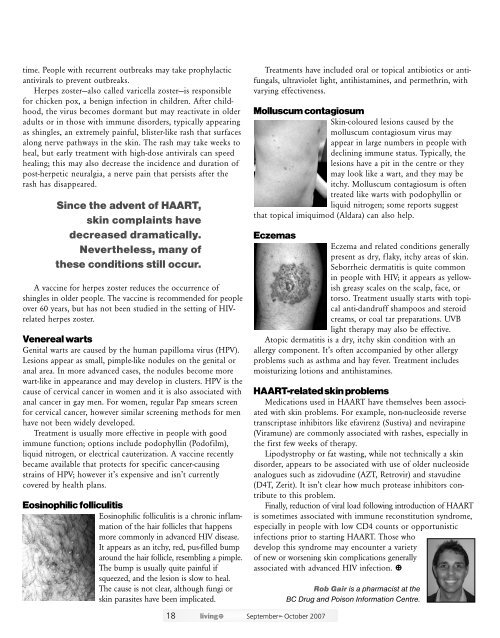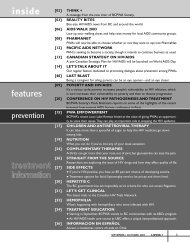iv poz mag.qxd - Positive Living BC
iv poz mag.qxd - Positive Living BC
iv poz mag.qxd - Positive Living BC
Create successful ePaper yourself
Turn your PDF publications into a flip-book with our unique Google optimized e-Paper software.
issue 50.<strong>qxd</strong>:l<strong>iv</strong> <strong>poz</strong> <strong>mag</strong>.<strong>qxd</strong> 9/3/07 4:04 PM Page 18<br />
time. People with recurrent outbreaks may take prophylactic<br />
ant<strong>iv</strong>irals to prevent outbreaks.<br />
Herpes zoster—also called varicella zoster—is responsible<br />
for chicken pox, a benign infection in children. After childhood,<br />
the virus becomes dormant but may react<strong>iv</strong>ate in older<br />
adults or in those with immune disorders, typically appearing<br />
as shingles, an extremely painful, blister-like rash that surfaces<br />
along nerve pathways in the skin. The rash may take weeks to<br />
heal, but early treatment with high-dose ant<strong>iv</strong>irals can speed<br />
healing; this may also decrease the incidence and duration of<br />
post-herpetic neuralgia, a nerve pain that persists after the<br />
rash has disappeared.<br />
Since the advent of HAART,<br />
skin complaints have<br />
decreased dramatically.<br />
Nevertheless, many of<br />
these conditions still occur.<br />
A vaccine for herpes zoster reduces the occurrence of<br />
shingles in older people. The vaccine is recommended for people<br />
over 60 years, but has not been studied in the setting of HIVrelated<br />
herpes zoster.<br />
Venereal warts<br />
Genital warts are caused by the human papilloma virus (HPV).<br />
Lesions appear as small, pimple-like nodules on the genital or<br />
anal area. In more advanced cases, the nodules become more<br />
wart-like in appearance and may develop in clusters. HPV is the<br />
cause of cervical cancer in women and it is also associated with<br />
anal cancer in gay men. For women, regular Pap smears screen<br />
for cervical cancer, however similar screening methods for men<br />
have not been widely developed.<br />
Treatment is usually more effect<strong>iv</strong>e in people with good<br />
immune function; options include podophyllin (Podofilm),<br />
liquid nitrogen, or electrical cauterization. A vaccine recently<br />
became available that protects for specific cancer-causing<br />
strains of HPV; however it’s expens<strong>iv</strong>e and isn’t currently<br />
covered by health plans.<br />
Eosinophilic folliculitis<br />
Eosinophilic folliculitis is a chronic inflammation<br />
of the hair follicles that happens<br />
more commonly in advanced HIV disease.<br />
It appears as an itchy, red, pus-filled bump<br />
around the hair follicle, resembling a pimple.<br />
The bump is usually quite painful if<br />
squeezed, and the lesion is slow to heal.<br />
The cause is not clear, although fungi or<br />
skin parasites have been implicated.<br />
Treatments have included oral or topical antibiotics or antifungals,<br />
ultraviolet light, antihistamines, and permethrin, with<br />
varying effect<strong>iv</strong>eness.<br />
Molluscum contagiosum<br />
Skin-coloured lesions caused by the<br />
molluscum contagiosum virus may<br />
appear in large numbers in people with<br />
declining immune status. Typically, the<br />
lesions have a pit in the centre or they<br />
may look like a wart, and they may be<br />
itchy. Molluscum contagiosum is often<br />
treated like warts with podophyllin or<br />
liquid nitrogen; some reports suggest<br />
that topical imiquimod (Aldara) can also help.<br />
Eczemas<br />
Eczema and related conditions generally<br />
present as dry, flaky, itchy areas of skin.<br />
Seborrheic dermatitis is quite common<br />
in people with HIV; it appears as yellowish<br />
greasy scales on the scalp, face, or<br />
torso. Treatment usually starts with topical<br />
anti-dandruff shampoos and steroid<br />
creams, or coal tar preparations. UVB<br />
light therapy may also be effect<strong>iv</strong>e.<br />
Atopic dermatitis is a dry, itchy skin condition with an<br />
allergy component. It’s often accompanied by other allergy<br />
problems such as asthma and hay fever. Treatment includes<br />
moisturizing lotions and antihistamines.<br />
HAART-related skin problems<br />
Medications used in HAART have themselves been associated<br />
with skin problems. For example, non-nucleoside reverse<br />
transcriptase inhibitors like efavirenz (Sust<strong>iv</strong>a) and nevirapine<br />
(Viramune) are commonly associated with rashes, especially in<br />
the first few weeks of therapy.<br />
Lipodystrophy or fat wasting, while not technically a skin<br />
disorder, appears to be associated with use of older nucleoside<br />
analogues such as zidovudine (AZT, Retrovir) and stavudine<br />
(D4T, Zerit). It isn’t clear how much protease inhibitors contribute<br />
to this problem.<br />
Finally, reduction of viral load following introduction of HAART<br />
is sometimes associated with immune reconstitution syndrome,<br />
especially in people with low CD4 counts or opportunistic<br />
infections prior to starting HAART. Those who<br />
develop this syndrome may encounter a variety<br />
of new or worsening skin complications generally<br />
associated with advanced HIV infection. 5<br />
Rob Gair is a pharmacist at the<br />
<strong>BC</strong> Drug and Poison Information Centre.<br />
18 l<strong>iv</strong>ing5 SeptemberqOctober 2007











